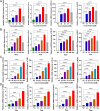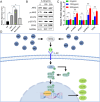TFF3 initiates gastric intestinal metaplasia by activating JAK2 and STAT3 under high salt conditions
- PMID: 40603642
- PMCID: PMC12222537
- DOI: 10.1038/s41598-025-09045-4
TFF3 initiates gastric intestinal metaplasia by activating JAK2 and STAT3 under high salt conditions
Abstract
The mechanism underlying the role of trefoil factor family 3 (TFF3) in intestinal metaplasia remains unclear. This study reveals the molecular mechanism by which TFF3, in the process of gastric mucosal epithelial cell intestinal metaplasia (IM) induced by high salt, activates the JAK2/STAT3/CDX2 pathway, providing a potential target for the occurrence of IM. An in vitro model of high salt-induced intestinal metaplasia was established using bioinformatics to screen the GEO dataset for significantly differentially expressed genes related to intestinal metaplasia. The gastric epithelial cell line GES-1 was cultured in high-salt medium, and changes in cell function and the expression of TFF3, JAK2, STAT3, and CDX2 were examined following TFF3 knockdown or overexpression. Subsequent experiments disrupted the TFF3-JAK2/STAT3-CDX2 pathway to assess its effects on gene expression and cell function. The expression of TFF3 is upregulated during intestinal metaplasia, which promotes cell proliferation and migration. TFF3 regulates the expression of JAK2, STAT3, and CDX2 and activates the JAK2/STAT3 pathway to induce CDX2 expression in gastric epithelial cells, leading to intestinal metaplasia. Functional assays revealed that the TFF3-JAK2/STAT3-CDX2 pathway enhances both cell proliferation and migration. TFF3 induces intestinal metaplasia in gastric epithelial cells through the JAK2/STAT3-CDX2 pathway, providing new insights into the underlying mechanism and therapeutic strategies for intestinal metaplasia.
Keywords: CDX2; High salt; Intestinal metaplasia; JAK2/STAT3; TFF3.
© 2025. The Author(s).
Conflict of interest statement
Declarations. Ethics approval and consent to participate: Experiments were approved by the Affiliated Hospital of Xuzhou Medical University (Ethics No. XYFY2024-KL017-01). In addition, I confirm that all methods were performed in accordance with the relevant guidelines and regulations by including a statement in the methods section. Competing interests: The authors declare no competing interests.
Figures















Similar articles
-
ADRB2 is regulated by TRIM22 and facilitates lung adenocarcinoma progression via JAK2/STAT3 signaling pathway.Sci Rep. 2025 Jul 1;15(1):22083. doi: 10.1038/s41598-025-06017-6. Sci Rep. 2025. PMID: 40594822 Free PMC article.
-
Phosphodiesterase 12 facilitates the growth and metastatic capabilities of gastric cancer cells by activating the TCAF2/JAK2/STAT3 axis.Biochim Biophys Acta Mol Basis Dis. 2025 Oct;1871(7):167973. doi: 10.1016/j.bbadis.2025.167973. Epub 2025 Jul 6. Biochim Biophys Acta Mol Basis Dis. 2025. PMID: 40628363
-
Chenodeoxycholic acid triggers gastric mucosal injury by inducing apoptosis and FXR activation.PLoS One. 2025 Jul 15;20(7):e0328000. doi: 10.1371/journal.pone.0328000. eCollection 2025. PLoS One. 2025. PMID: 40663543 Free PMC article.
-
Regulation and therapy, the role of JAK2/STAT3 signaling pathway in OA: a systematic review.Cell Commun Signal. 2023 Apr 3;21(1):67. doi: 10.1186/s12964-023-01094-4. Cell Commun Signal. 2023. PMID: 37013568 Free PMC article.
-
Adenocarcinoma risk in gastric atrophy and intestinal metaplasia: a systematic review.BMC Gastroenterol. 2017 Dec 11;17(1):157. doi: 10.1186/s12876-017-0708-4. BMC Gastroenterol. 2017. PMID: 29228909 Free PMC article.
References
-
- Sung, H. et al. Global cancer statistics 2020: GLOBOCAN estimates of incidence andmortality worldwide for 36 cancers in 185 countries. Cancer J. Clin.71, 209–249. 10.3322/caac.21660 (2021). - PubMed
-
- Dias-Neto, M. et al. Salt intake and risk of gastric intestinal metaplasia: systematic review and meta-analysis. Nutr. Cancer. 62, 133–147. 10.1080/01635580903305391 (2010). - PubMed
MeSH terms
Substances
Grants and funding
- 2023ZL19/the Project supported by the Affiliated Hospital of Xuzhou Medical University
- KYCX25_3282/Postgraduate Research & Practice Innovation Program of Jiangsu Province
- KC22233/the Key Development Project of Science and Technology Bureau in Xuzhou
- XZSYSKF2021029/the Key Laboratory of Jiangsu Province Open project
LinkOut - more resources
Full Text Sources
Miscellaneous

